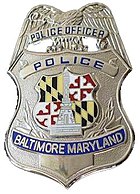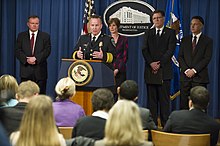
A | B | C | D | E | F | G | H | CH | I | J | K | L | M | N | O | P | Q | R | S | T | U | V | W | X | Y | Z | 0 | 1 | 2 | 3 | 4 | 5 | 6 | 7 | 8 | 9
| Baltimore Police Department | |
|---|---|
 Patch of the Baltimore Police Department | |
 Baltimore Police Department seal | |
 Badge of the Baltimore Police Department | |
| Common name | Baltimore Police Department |
| Abbreviation | BPD |
| Motto | Semper Paratus, Semper Fideles, Ever on the Watch Ever Ready, Ever Faithful, Ever on the Watch |
| Agency overview | |
| Formed | 1784 |
| Employees | 2,935 (2020)[1] |
| Annual budget | $536 million (2020)[1] |
| Jurisdictional structure | |
| Operations jurisdiction | Baltimore, Maryland, United States |
 | |
| Baltimore Police Districts | |
| Size | 80.95 square miles (209.7 km2) |
| Population | 602,495 (2018) |
| Legal jurisdiction | Baltimore, Maryland |
| General nature | |
| Operational structure | |
| Headquarters | Bishop L. Robinson, Sr. Police Administration Building 601 E Fayette St Baltimore, Maryland 21202 |
| Officers | 2,514 (2017)[2] |
| Mayor of Baltimore responsible | |
| Agency executives |
|
| Parent agency | Baltimore City Council |
| Facilities | |
| Districts | 1-Central 2-Southeast 3-Eastern 4-Northeast 5-Northern 6-Northwest 7-Western 8-Southwest 9-Southern |
| Marked and unmarked vehicles | Chevrolet Suburbans, Tahoes, Caprices, Ford Taurus Interceptors, Utility Interceptors, Explorers, Escapes, Mustangs and Harley-Davidson Police Motorcycles, Toyota Tundra, Ford F150 |
| Helicopters | 2x Eurocopter EC 120 called Foxtrot |
| Horses | 12 |
| Website | |
| Baltimore Police Website | |
The Baltimore Police Department (BPD) is the municipal police department of the city of Baltimore, Maryland. Dating back to 1784, the BPD, consisting of 2,935 employees in 2020, is organized into nine districts covering 80.9 square miles (210 km2) of land and 11.1 square miles (29 km2) of waterways. The department is sometimes referred to as the Baltimore City Police Department to distinguish it from the Baltimore County Police Department.
History
Foundation to the 1840s
The first attempt to establish professional policing in Baltimore was in 1784, nearly 60 years after the founding of the colonial town and eight years after United States independence. The city authorized a night watch and a force of day constables to enforce town laws. Nightwatchman George Workner was the first law enforcement officer to be killed in the city; he was stabbed during an escape attempt by nine inmates at Baltimore City Jail on March 14, 1808.[3]
The department was founded in its current form (with uniforms and firearms) in 1853 by the Maryland state legislature "to provide for a better security for life and property in the City of Baltimore". The state did not give the city the power to run its own police affairs. The early decades of the department were marked by internal political conflict over split loyalties. In 1857 the police were reorganized by Mayor Thomas Swann and new men were recruited; many came from Know Nothing gangs in the city and maintained loyalties to former leaders.[4] The first BPD officer to die in the line of duty was Sergeant William Jourdan, who was shot and killed by an unknown gunman during the first city council elections on October 14, 1857.[5][6]
In 1861, during the U.S. Civil War, the police department was taken over by the federal government after police helped push pro-U.S. and pro-Confederate rioters into a full-out armed confrontation in the Baltimore riot of 1861. The U.S. military ran the police department until 1862, when they turned authority back to the state legislature.
The department introduced call boxes in 1885, the Bertillon identification system in 1896, and radio communications in 1933.
The 1930s to the Civil Rights era
The first African American officer hired by the department was a woman: Violet Hill Whyte, in 1937.[7] The first black male officers (Walter T. Eubanks Jr., Harry S. Scott, Milton Gardner, and J. Hiram Butler Jr.) were hired the year after. They were all assigned to plainclothes duty to work undercover.[8] In 1943, African Americans were allowed to wear police uniforms, and by 1950 there were 50 black officers in the department.[8]
African American officers at this point were barred from using squad cars, hit a ceiling in promotion and were limited to patrolling black neighbourhoods or assignments in the Narcotics Division or as undercover officers.[9] They were subjected to racial harassment from both white coworkers (including the use of racial slurs during roll call[10]) and African American residents (including degrading racial graffiti). Bishop L. Robinson and Edward J. Tilghman were two black police officers during this period; both later served as police commissioner.[9] Local Republican politician Marse Callaway played a significant role in increasing the number of African American officers.[citation needed]In 1962, Patrolman Henry Smith Jr. was the first African American officer to die in the line of duty; he was shot breaking up a dice game on North Milton Avenue.[11]

As with other American cities post-World War II suburbanization, encouraged by government programs, drew large numbers of white residents out of the city. There had always been a large African American minority in Baltimore, which had been growing steadily and became a majority in the mid 20th century. The police department remained dominated by whites; traditionally mostly Irish Americans.[12]

During the Civil Rights Movement, trust between the department and the predominantly black city became increasingly strained, as African Americans pressed for fair treatment and social justice. In the 1960s, race riots erupted in Baltimore and other cities. Some positive change was implemented under Commissioner Donald Pomerleau, appointed in 1966 after consulting for the International Association of Chiefs of Police in the city for two years and writing a damning report on the department.[13] Pomerleau described the BPD as "the most corrupt and antiquated in the nation, and had developed almost no positive relationship with the city's Negro community".[14] Pomerleau oversaw many reforms, including the racial integration of the department by 1966, also partly a result of the Civil Rights Act of 1964 and efforts by local black activists.[9] However, the riot of 1968 broke out across the city's African-American neighborhoods in response to the assassination of Martin Luther King Jr. Because few black officers held rank within the department,[15] the African American community was confronted by a white-dominated police department.
Late 20th century to present
In the latter part of the 20th century, restructuring of industry and railroads resulted in a massive loss of industrial jobs in Baltimore. These changes resulted in depopulation, unemployment and poverty; all serious challenges for the police department.
Police community relations were severely strained in Baltimore during the "war on drugs", as with other cities, adding to the stresses of several African American neighborhoods in East and West Baltimore already hollowed out by drug use. African American police officers were intensely disliked, as were white ones.[16]
In 1971, African American officers founded the Vanguard Justice Society, to represent their rights and interests.[17] Throughout the 1970s, more African Americans advanced in the department;[17][18][19][20] Black officers were promoted to positions of district commanders and chief of patrol.
In July 1974, officers joined other striking municipal workers for five days during the Baltimore police strike.
In 1984, Mayor Donald Schaefer appointed veteran police officer Bishop L. Robinson as Baltimore's first black police commissioner.[21] The department had previously long been dominated by ethnic Irish American and briefly by Italian Americans.[22][23] Robinson had been the force's first Black officer to command the Eastern District and the Patrol Division. The department redefined several of its policies in effort to avoid the mistakes other departments made in the Watts riots of Los Angeles and Liberty City riots in Miami.
The department began using computerized booking procedures and 911 emergency systems in 1985, and created the first ever 311 non-emergency system in 1996. CCTV cameras began to be used in the same year, while the CitiStat system was introduced in 2000,[24] enabling police to concentrate resources where they would be most needed or effective. During Martin O'Malley's administration as mayor, the department was made up of 43% African American officers.[25]
Following the death of Freddie Gray in police custody in 2015, there was rioting in black neighborhoods. The city invited the Department of Justice to conduct an investigation of the police department and its relations with the community. It found evidence of widespread unconstitutional and discriminatory police practices in the city, especially in poor, black neighborhoods.

Following reporting from the investigation, the city, police department and the Civil Rights Division of DOJ negotiated a consent decree,
including limits on when and how the can engage individuals suspected of criminal activity. It orders more training for police on de-escalation tactics and interactions with youths, those with mental illness and protesters, as well as more supervision for officers.[26]
U.S. District Judge James K. Bredar approved the decree in early April 2017, with commitment from Mayor Catherine Pugh and Police Commissioner Kevin Davis to make the changes proposed. Pugh already had included $10 million in the city budget for this purpose. The city will also be required to invest in better technology and equipment, and "for the Police Department to enhance civilian oversight and transparency." He denied a Department of Justice request to postpone signing the decree for 30 days in order to allow review by the Trump Administration.[26][27]
On May 10, 2018, newly appointed Police Commissioner Darryl De Sousa was charged in U.S. District Court with three misdemeanor counts of failing to file federal taxes for 2013, 2014 and 2015.[28] Mayor Catherine Pugh initially expressed support for De Sousa, but a day later she suspended him with pay pending the resolution of the charges against him.[29] De Sousa resigned several days later.[30]
In 2021, the Maryland General Assembly passed a bill to transfer full control of the department from the state to the city. The transfer is contingent on city voters' approval of a charter amendment.[31] Mayor Brandon Scott plans to assemble a panel tasked with finding ways that funding could be shifted from police to other agencies.[32] Though Gov. Larry Hogan publicly questioned Scott's plans, he let the bill become law without his signature.[33]
As of 2021, 60% of sworn BPD officers were racial or ethnic minorities, with both black and white officers making up 40% of the force. Female officers comprised 15% of the department.[34]
Mergers
The department absorbed the City Park Police in the early 1960s. In 2005, the Housing Authority Police were disbanded and operations taken over by the Baltimore Police Department. Housing Authority officers had to reapply for jobs with the city police, losing any previous seniority. In the 2010s, there has been discussion of merging the Baltimore Schools Police into the department as well.[35]
Rank structure and insignia
This section needs to be updated. (February 2024) |








